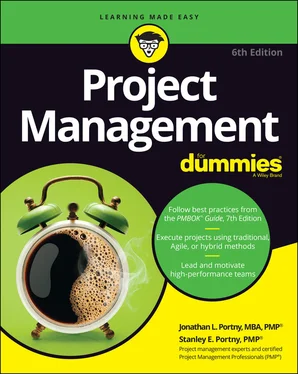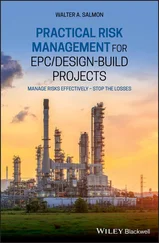Data gathering and analysis: You are already familiar with several methods in this category, like the business case, cost-benefit analysis, feasibility study, and stakeholder analysis (part of creating the project charter covered earlier in this chapter). Data gathering and analysis methods help you collect, analyze, and evaluate facts and data to provide insight into a particular situation.
Estimating: Some commonly used estimating methods include story point estimating in Agile Project Management (see Chapter 18for more on Agile), affinity grouping (such as “T-shirt sizing”), and analogous estimating. Analogous estimating uses tasks and projects performed previously to inform estimates for similar tasks and projects to be performed. Generally, estimating methods facilitate your approximation of effort, duration, or cost.
Meeting and events: You’re probably familiar, perhaps all too familiar, with the meetings you conduct throughout your projects. It is important to balance the need to engage and communicate with various stakeholder groups during a project with the risk of inducing “meeting fatigue” or “meeting overload” and detracting from the execution of the project work itself. That said, meetings and events are critical to project success, so let’s review some of the key ones that add value to nearly all projects: Kickoff meeting: Formally starts the project (or a specific phase of the project) and aligns the team and key stakeholders to the project’s goals and expectations. Standup meeting : A brief, usually 15 minute, daily session where you review progress from the prior day, review planned work for the current day, and call out any obstacles that might impede the team’s future progress. In Agile, this is called the “daily scrum.” Iteration/milestone/phase/Sprint review : This meeting is conducted once all the work for a specific phase of the project has been completed. Depending on the type of project, this review may include a demonstration and often culminates in a go/no-go decision to proceed to the next phase of the project. Status meeting : An opportunity to update stakeholders and review progress to date, status meetings are often accompanied by a status report, to indicate performance against budget, schedule, and milestones that may be reviewed with the attendees. Steering committee meeting: Comprised of senior-level stakeholders (from the client, your organization, and even vendors and contractors when appropriate) who provide direction and support to the project team and are empowered to make decisions outside of the project team’s authority. Project retrospective: Often referred to as a project post-mortem, a lessons learned meeting, or a project review and closeout meeting, a retrospective takes an objective look at all aspects of a recently completed project for two purposes: first, to ensure that mistakes or undesirable outcomes are understood so they can be avoided in the future; and second, to ensure that positive accomplishments of the project are called out, celebrated, and able to be repeated in future projects.
 Artifacts are templates, outputs, or deliverables that result from one or more of the methods you just reviewed. Some projects require acutely specialized artifacts, relevant only to your industry, organization, or stakeholders. Many of the most often used artifacts are broadly applicable to most industries, organizations, and stakeholders. Many of these artifacts are explained in detail throughout this book, so we keep this list high-level for now.
Artifacts are templates, outputs, or deliverables that result from one or more of the methods you just reviewed. Some projects require acutely specialized artifacts, relevant only to your industry, organization, or stakeholders. Many of the most often used artifacts are broadly applicable to most industries, organizations, and stakeholders. Many of these artifacts are explained in detail throughout this book, so we keep this list high-level for now.
Strategy artifacts: Created prior to or at the onset of a project and referred to throughout the project to ensure they are satisfied by the project output. Examples include: Business case : See “ Proposing a project in a business case” section earlier in this chapter for details. Project charter : See “ Developing the Project Charter” section earlier in this chapter for details. Roadmap : A high-level timeline that shows milestones, key review and decision points, and is often subdivided into more manageable phases.
Logs and registers: Ongoing records of continuously evolving factors. Examples include: Risk register : Risks, actions, issues, and decisions are often consolidated into a single log, called the RAID log. See the section “Preparing a Risk Management Plan” in Chapter 10for more on risks. Issue log: The previous comment for risk register also applies to the issue log. Stakeholder register : More than just a contact list, this register classifies and assesses each stakeholder for the role they play in their organization and on the project. See Chapter 4for more on this.
Plans: Proposed means to achieve project goals. Examples include: Communications plan : Describes how, when, and by whom project communications will be disseminated. See Chapter 15for more on this. Resource management plan : Explains how resources are identified, onboarded (or procured), supported (or maintained), and managed (or utilized) throughout the project. See Chapter 8for more on human resource management (and Chapter 9for non-personnel resource management). Risk management plan : Defines how risk will be triaged, classified, and addressed. See Chapter 10for more on this. Change control plan : Presents the process to document, assess, and implement changes, whether they have a contractual or other impact to the project or not. See Chapter 14for more on change control.
Hierarchy charts: High-level info broken down into levels of increasingly greater detail. Examples include: Work breakdown structure (WBS) : One of the most universally applicable and fundamental project management artifacts, the WBS decomposes the overall project scope into lower-level (and more detailed) tasks. Your goal should always be to define your WBS down to the most granular level of detail possible. See Chapter 14for more on this. Organizational breakdown structure : Not to be confused with an “org chart,” this chart represents the relationship between tasks or activities and the organizational units assigned to them.
Baselines: Approved plans against which progress is tracked to help identify and quantify variances. Examples include: Project schedule : Sometimes called a project plan and often presented in the form of or in conjunction with a Gantt chart, the project schedule illustrates linked tasks with planned dates, durations, milestones, and resource assignments. See Chapter 7for more on this. Budget : The approved cost estimate for the project or component of your WBS. See Chapter 9for more on this.
Visual data and information: Charts, graphs, and diagrams to graphically present complex data in a visual manner that can be easier to digest and interpret. Examples include: Gantt chart : A graphical illustration of the project schedule that visually indicates task durations and dependencies throughout the project timeline. See Chapter 7for more on this. Responsibility assignment matrix (RAM) : One of the most common versions of a RAM is the RACI , which defines who is responsible, accountable, consulted, or informed for or about project activities, decisions, and deliverables. See Chapter 12for more on this. Dashboards : Graphical representations of project metrics and KPIs that provide at-a-glance views of overall status. See Chapter 15for more on this.
Reports: Formal records of pertinent project information. Examples include: Status report : Usually includes progress made since last report, activities planned until the next report, budget and schedule status, risks and issues. See Chapter 15for more on this. Quality report : Documents any quality management issues, corrective actions and recommendations for process, project, and product improvements to prevent similar quality issues from recurring.
Читать дальше

 Artifacts are templates, outputs, or deliverables that result from one or more of the methods you just reviewed. Some projects require acutely specialized artifacts, relevant only to your industry, organization, or stakeholders. Many of the most often used artifacts are broadly applicable to most industries, organizations, and stakeholders. Many of these artifacts are explained in detail throughout this book, so we keep this list high-level for now.
Artifacts are templates, outputs, or deliverables that result from one or more of the methods you just reviewed. Some projects require acutely specialized artifacts, relevant only to your industry, organization, or stakeholders. Many of the most often used artifacts are broadly applicable to most industries, organizations, and stakeholders. Many of these artifacts are explained in detail throughout this book, so we keep this list high-level for now.










